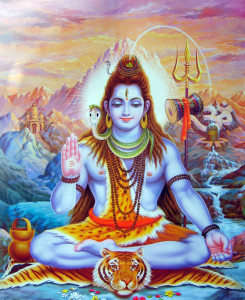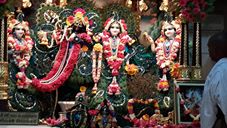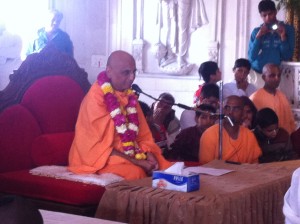Hare Krishna
7th April, 2015. Gurgaon
Q: What are the five layers of ignorance which covers a Jiva ?
Answer :
tāmisra: being envious of supreme Lord.
andha-tāmisra : considering death to be the ultimate end.
tamas : condition of not knowing anything about the spirit soul.
moha : illusion of the bodily concept of life, me and mine.
mahā-moha : to be mad after material enjoyment.
First of all, Brahmā created from his shadow the coverings of ignorance of the conditioned souls. They are five in number and are called tāmisra, andha-tāmisra, tamas, moha and mahā-moha. (SB 3.20.18)
Srila Prabhupada explains them in detail in his purport :
The conditioned souls, or living entities who come to the material world to enjoy sense gratification, are covered in the beginning by five different conditions. The first condition is a covering of tāmisra, or anger. Constitutionally, each and every living entity has minute independence; it is misuse of that minute independence for the conditioned soul to think that he can also enjoy like the Supreme Lord or to think, “Why shall I not be a free enjoyer like the Supreme Lord?” This forgetfulness of his constitutional position is due to anger or envy.
The living entity, being eternally a part-and-parcel servitor of the Supreme Lord, can never, by constitution, be an equal enjoyer with the Lord. When he forgets this, however, and tries to be one with Him, his condition is called tāmisra. Even in the field of spiritual realization, this tāmisra mentality of the living entity is hard to overcome. In trying to get out of the entanglement of material life, there are many who want to be one with the Supreme. Even in their transcendental activities, this lower-grade mentality of tāmisra continues.
Andha-tāmisra involves considering death to be the ultimate end. The atheists generally think that the body is the self and that everything is therefore ended with the end of the body. Thus they want to enjoy material life as far as possible during the existence of the body. Their theory is: “As long as you live, you should live prosperously. Never mind whether you commit all kinds of so-called sins…. No one is responsible for anything he does during his life.” This atheistic conception of life is killing human civilization, for it is without knowledge of the continuation of eternal life.
This andha-tāmisra ignorance is due to tamas. The condition of not knowing anything about the spirit soul is called tamas. This material world is also generally called tamas because ninety-nine percent of its living entities are ignorant of their identity as soul. Almost everyone is thinking that he is this body; he has no information of the spirit soul. Guided by this misconception, one always thinks, “This is my body, and anything in relationship with this body is mine.” For such misguided living entities, sex life is the background of material existence…
As these attachments increase, moha, or the illusion of the bodily concept of life, also increases. Thus the idea that “I am this body, and everything belonging to this body is mine” also increases, and as the whole world is put into moha, sectarian societies, families and nationalities are created, and they fight with one another.
Mahā-moha means to be mad after material enjoyment. Especially in this age of Kali, everyone is overwhelmed by the madness to accumulate paraphernalia for material enjoyment.
Srila Prabhupada adds in his purport: The Lord is described here by the word viviktādhyātma-darśanaḥ. If anyone can completely perceive another’s distress without doubt, it is the Lord Himself. If someone is in distress and wants to get relief from his friend, sometimes it so happens that his friend does not appreciate the volume of distress he is suffering. But for the Supreme Lord it is not difficult. The Supreme Lord, as Paramātmā, is sitting within the heart of every living entity, and He directly perceives the exact causes of distress. In Bhagavad-gītā the Lord says, sarvasya cāhaṁ hṛdi sanniviṣṭaḥ: “I am sitting in everyone’s heart, and because of Me one’s remembrance and forgetfulness occur.” Thus whenever one fully surrenders unto the Supreme Lord, one finds that He is sitting within one’s heart. He can give us direction how to get out of dangers or how to approach Him in devotional service.
Q: What is the purpose of ritualistic sacrifices?
Ans: To gradually revive the spiritual realization of the living entities.
They prayed: O creator of the universe, we are glad; what you have produced is well done. Since ritualistic acts have now been established soundly in this human form, we shall all share the sacrificial oblations. (SB 3.20.18)
Srila Prabhupada writes in his purport to the above verse : The importance of sacrifice is also mentioned in Bhagavad-gītā, Third Chapter, verse 10. The Lord confirms there that in the beginning of creation Brahmā created the Manus, along with the ritualistic sacrificial method, and blessed them: “Continue these sacrificial rites, and you will be gradually elevated to your proper position of self-realization and will also enjoy material happiness.” All the living entities created by Brahmā are conditioned souls and are inclined to lord it over material nature. The purpose of sacrificial rituals is to revive, gradually, the spiritual realization of the living entities. That is the beginning of life within this universe. These sacrificial rituals, however, are intended to please the Supreme Lord. Unless one pleases the Supreme Lord, or unless one is Kṛṣṇa conscious, one cannot be happy either in material enjoyment or in spiritual realization.
Q: Does these ritualistic sacrifices in themselves suffice to make us a spiritually realised soul ?
Reply : No. Srila Prabhupada explains in the purport of SB 3.20.52 The ritualistic performances of sacrifice are meant for material economic development; in other words, they are meant to keep the body in good condition for cultivation of spiritual knowledge. But for actual attainment of spiritual knowledge, other qualifications are needed. What is essential is vidyā, or worship of the Supreme Lord. Sometimes the word yoga is used to refer to the gymnastic performances of different bodily postures which help mental concentration. Generally, the different bodily postures in the yoga system are accepted by less intelligent men to be the end of yoga, but actually they are meant to concentrate the mind upon the Supersoul. After creating persons for economic development, Brahmā created sages who would set the example for spiritual realization.
Q: Can one enjoy the material world and also become spiritually realised ?
Ans : No.
To each one of these sons the unborn creator of the universe gave a part of his own body, which was characterized by deep meditation, mental concentration, supernatural power, austerity, adoration and renunciation. (SB 3.20.53)
Srila Prabhupada expands it further in his purport : The word viraktimat in this verse means “possessed of the qualification of renunciation.” Spiritual realization cannot be attained by materialistic persons. For those who are addicted to sense enjoyment, spiritual realization is not possible. In Bhagavad-gītā it is stated that those who are too attached to seeking material possessions and material enjoyment cannot reach yoga-samādhi, absorption in Kṛṣṇa consciousness. Propaganda that one can enjoy this life materially and at the same time spiritually advance is simply bogus. The principles of renunciation are four: (1) to avoid illicit sex life, (2) to avoid meat-eating, (3) to avoid intoxication and (4) to avoid gambling. These four principles are called tapasya, or austerity. To absorb the mind in the Supreme in Kṛṣṇa consciousness is the process of spiritual realization.
All glories to Srimad Bhagavatam.
All glories to Sri Guru and Gauranga.
All glories to Srila Prabhupada.








